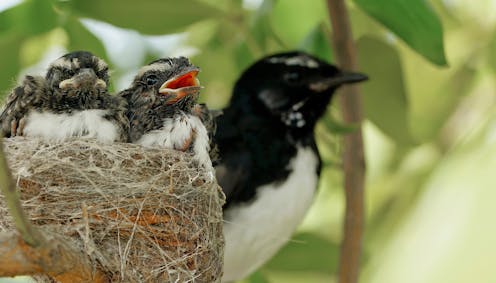This Mother's Day, let's celebrate the brave, multi-tasking mums of the Australian bird world
- Written by Ayesha Tulloch, ARC Future Fellow, Queensland University of Technology

In the human fascination with birds, it’s the flashy appearance and antics of males that get the most attention from researchers and the public.
From their colourful plumage to elaborate songs and courtship displays, male birds often steal the show. This has led to female birds routinely being overlooked[1] by conservation planners.
First, let’s clear up a few misconceptions. At least 70% of female birds sing[2] – a fact historically overlooked due to research and survey biases towards males. And while many female birds have more muted colours than males, there are numerous examples of females with brilliant plumage[3].
But the wonders of the female bird world go far deeper. The capacity of female birds to rear and protect their young is phenomenal. Somehow, they manage to hold their families together despite predators, harsh conditions and sometimes, a less-than-attentive partner.
Satin bowerbirds: an unequal domestic burden
The male bowerbird is one of the most over-the-top bachelors of the bird world.
Male satin bowerbirds have striking[4], iridescent blue plumage and violet-coloured eyes. Females, on the other hand, are green and brown to blend into their surroundings.
To attract a mate, the male dances[5] in an exaggerated fashion and makes a decorated bower. Females visit various bowers and select their mate. After that, the female basically does everything.
She makes the nest – usually high in a tree to protect nestlings from predators such as goannas. She produces and incubates the eggs on her own. And once the chicks hatch, the mum alone feeds them and defends the nest.
Meanwhile, the male bowerbird fusses over his man-cave – or bower – throughout the year in the hope of attracting another mate.
Read more: Women have disrupted research on bird song, and their findings show how diversity can improve all fields of science[6]
Palm cockatoos: the female bodyguard
Male palm cockatoos shot to fame a few years ago when new research identified their drumming[7] abilities. The males make drumsticks from branches and bang them rhythmically against a tree for pair-bonding or sometimes to claim territory.
But once the palm cockatoos pair up, the female plays a crucial role in securing their territory for breeding. During many months of behavioural observations, we found the female sits sentinel (kind of like a bodyguard) on the tree hollow while the male goes inside, splintering sticks with his massive bill to make the nest.
If danger comes – perhaps a neighbouring cockatoo pair or predator – the female alerts her mate and chases away the intruder.
Virtuosic lady lyrebirds
The impressive repertoire[8] of male superb lyrebirds is well-known. But it was only in recent years, when researchers turned their attention to the female, that her incredible singing ability was discovered[9].
Male lyrebirds don’t help[10] with nest-building, incubation, brooding or feeding young.
Left alone to rear and protect her offspring, the female lyrebird has developed a cunning ability to confuse predators by mimicking the calls of at least 19 other bird species.
The female lyrebird is also remarkable for the length of time she cares for her young. Once fully feathered and able to fly, young lyrebirds remain dependent on their mothers and may stay in their care for more than a year[11].
Fairy-wren code-makers
The Horsfield’s bronze-cuckoo does not build its own nest but instead lays its eggs in the nests of other birds such as fairy-wrens. This can leave the fairy-wren mother expending precious time and food raising another bird’s chicks.
But the female superb fairy-wren has developed a truly ingenious way to detect foreign nestlings once the eggs hatch.
She sings to her eggs – and includes in the song a specific “password[12]”. Once her chicks hatch, they sing the password when begging for food.
It can be hard for the fairy-wren mum to differentiate her young in her dark, ball-shaped nest. But she can identify her offspring by their song. Cuckoo nestlings can’t learn or sing the password so are less likely to get fed.
Eclectus parrot: the ultimate nest defender
Even though nesting only takes a few months, female eclectus parrots guard their precious hollows[13] for up to nine months[14].
This is why their plumage is red[15] and their male counterparts are green.
The red serves as a beacon screaming “this hollow is taken!”, helping keep cockatoos away.
Here’s to all mums
Female birds are just as worthy of our time and research effort as their male counterparts. Considering the behaviours and needs of female birds is especially vital from a conservation perspective.
What’s more, affirming the important role of females in any community – bird or human – is crucial to achieving more equitable and just societies. Never is that message more important than on Mother’s Day.
Read more: What Australian birds can teach us about choosing a partner and making it last[16]
References
- ^ overlooked (doi.org)
- ^ female birds sing (www.sciencedaily.com)
- ^ brilliant plumage (royalsocietypublishing.org)
- ^ striking (australian.museum)
- ^ dances (academic.oup.com)
- ^ Women have disrupted research on bird song, and their findings show how diversity can improve all fields of science (theconversation.com)
- ^ drumming (www.science.org)
- ^ repertoire (www.theguardian.com)
- ^ discovered (www.allaboutbirds.org)
- ^ don’t help (absa.asn.au)
- ^ more than a year (www.publish.csiro.au)
- ^ password (www.sciencedirect.com)
- ^ precious hollows (www.publish.csiro.au)
- ^ nine months (www.cambridge.org)
- ^ red (www.sciencedirect.com)
- ^ What Australian birds can teach us about choosing a partner and making it last (theconversation.com)

















